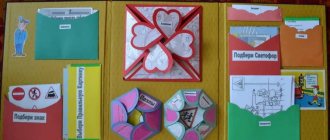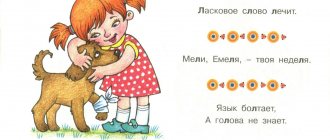The development of speech in preschool children is of great importance. Correctly formed and developed speech is the basis for further success in a child’s education at school. If a child swaps syllables or sounds in his speech, he will write and read in the same way. A meager vocabulary will prevent a child from retelling texts, writing expositions, essays, or explaining solutions to problems. Trying to correct such omissions a couple of months before school is a pointless exercise that will bring nothing but stress to the child. But in a couple of years it’s possible to do this even at home. Games for speech development, correctly selected for children 5–6 years old, can help with this.
Speech on the threshold of school: characteristic features
Upon reaching the age of 5–6 years, the child already has a sufficient command of his native language: its grammar, phonetics, and vocabulary. He knows how to express his thoughts emotionally, coherently and logically, but at the same time consistently and expressively.
If we talk about the development of speech at 5–6 years old, then its features are as follows.
- Lexicon.
The active vocabulary of a preschooler at this age can contain up to 3 thousand words. He understands many general terms (animals, birds - wild or domestic, berries, trees, transport, professions). The conceptual apparatus includes a wide variety of topics: a child is able to think, for example, not only about the change of seasons and the behavior of animals, but also about such complex things as dreams, space, love, family. There are practically no pronunciation errors in the speech in the form of added, rearranged or replaced syllables or sounds. This is only possible with polysyllabic words that are rarely used (excavator, hairdresser, armored personnel carrier). But, as a rule, if adults draw the child’s attention to this mistake, he does not repeat it again.
- Grammar.
Children of this age are able to answer a question on a familiar topic by constructing a complete, detailed sentence. By the age of 6, a child’s phrases become increasingly longer and more common, and most words are used in the correct form. Sometimes there are speech errors (“theirs”, “bear cubs”).
- Pronunciation.
Usually, by the age of six, the speech apparatus of a preschooler - in the absence of anatomical abnormalities (high palate, short hyoid frenulum) - is fully formed, and there are practically no difficulties with pronouncing sounds. Possible problems with articulation are incorrect positioning of the tongue when pronouncing the sounds [r] and [l] (their replacement with other sounds or omission in speech). Sometimes hissing ones suffer. Children at this age are already able to notice incorrect pronunciation in themselves and others. If by the age of 5–6 years a preschooler has problems with the pronunciation of certain sounds, most likely he will no longer be able to cope with them on his own - he will need the help of a specialist.
- Coherent speech.
Older preschoolers are able to retell a work they have read, compose a coherent story based on a picture or a group of related pictures, come up with the beginning or end of a proposed story, share impressions about interesting events, a cartoon they watched, or games with friends. They already know how to consciously select the most appropriate words to express their feelings and thoughts. Children accurately describe objects and also find the desired object based on the description.
- Expressiveness.
A child aged 5–6 years can speak softer or louder, slower or faster. He knows how to speak in a whisper, read poetry by heart with expression, choosing the right intonation, making logical pauses.
Tasks for correcting the phonetic aspect of speech
It is the basis for further correctional work and the development of reading and writing skills.
- Acquaintance with the concepts of “sound”, “word”, “sentence”. Children are asked what sounds they know, what the word consists of. The speech therapist explains that each word has a specific meaning. Diagrams and cards are used as visual material.
- “Find the sound” - the goal of this task is to teach how to isolate the desired sound in a word. They start with simple - isolated pronunciation, then in syllables, and then in words.
- “How many windows are there in the house” is a game to determine the number of syllables in a word. Before giving this task, the concept of “syllable” must be formed. It is proposed to divide words into groups according to the number of syllables.
- “Assemble a basket” - the speech therapist suggests collecting words that are somewhat similar into a basket. They can start with the same sound or have the same number of syllables. An adult asks why these particular words are collected in one basket.
- “What flies, swims, drives.” The speech therapist lays out pictures depicting an airplane, a motor ship, a tram, a trolleybus. The child is asked questions about how to name them in one word; how many syllables they have and other questions regarding sound-letter analysis. Then they ask you to make a sentence with one of these words.
Carrying out correctional work on the formation of the phonetic side is the prevention of the appearance of dysgraphia and dyslexia - disorders of the reading and writing processes.
How can games help?
The game form is most favorable for mastering various skills, including speech. Properly selected games help improve various aspects of speech and communication culture.
The main directions of speech development for older preschoolers in the form of games:
- intonation and dynamic expressiveness of speech;
- correct tempo, rhythm;
- clarity of pronunciation;
- setting the correct stress;
- the ability to put words into correct grammatical forms;
- the ability to clearly and completely formulate your thoughts;
- vocabulary enrichment;
- development of monologue and dialogic speech;
- formation of prerequisites for mastering written speech.
At the same time, it is important that the child perceives all tasks as a call to participate in the game, and not a boring activity (repeat, give an example, find). Accordingly, the child’s motivation for play activities and interest in them is much higher than in lessons on speech development. This means the effect will be more noticeable.
In the process of playful communication with a preschooler, do not “suppress” his emotions and feelings, give him the opportunity to express them. Otherwise, the child’s need for communication as such will gradually decrease, which means that speech activity will also decrease. If at some point the child cannot find the right word, let him express his thought using facial expressions, gestures, and plastic movements.
Work on lexico-grammatical structure
At the age of 6-7 years, children experience a strong increase in vocabulary. They use more and more words in their active speech and master all grammatical skills. During this period, children lay the foundation for successful literacy acquisition in school. Work is carried out in the following areas:
- clarifying the meaning of words;
- introduction of adjectives and verb vocabulary into speech;
- ability to select synonyms;
- developing the ability to accurately name an object, its purpose and properties;
- working with antonym words;
- developing the ability to listen carefully to the text;
- teaching word formation;
- development of coordination skills.
Children are asked questions about the objects around them and asked clarifying questions. They work not only with nouns, but also with verb vocabulary. The task of a speech therapist is to expand the vocabulary and teach how to use words in speech in the correct meaning.
- “Tell me which one?” A poem is read to children - it must be illustrated. The guys are asked questions so that the answer to them is adjective words.
- "Guess the object." An adult describes an object to children, and they must guess what it is about. This can be a description of not only its appearance, but also its properties. Then the adult and child change places.
- “Say the opposite.” Pictures are laid out in front of the children. They are asked to name what is depicted on them and choose the opposite meaning. Then the task becomes more complicated: they show an illustration that contains antonym words (tall tree, low house, etc.). Children must make sentences using antonyms.
- "Confusion". A fable is read to the child, showing a suitable illustration. After reading it, the adult asks what is true in this poem and what the author made up or confused.
- “Choose the right word.” The adult reads out a short text: “Dad decided to make a kennel. His son brought him boards. “No, they don’t fit - the kennel will break.” His son brought him others. “But they will make a wonderful house for a dog!” The child is asked which boards the boy brought first and which ones dad liked.
For 6-7 year old children, the most difficulties arise when agreeing adjectives and nouns in the neuter gender, forming a verb in the imperative mood. Therefore, when performing the proposed tasks, special attention should be paid to this.
Each game has its own goal
Finding or inventing a game to develop speech is not so difficult. The main thing is to understand that each type of game has its own goal, by achieving which the child develops one or another skill.
All exercises and games for children 5–6 years old can be divided into 4 groups.
- Games that develop the sound culture of speech. In them, the child improves phonemic hearing, learns to determine the location of sounds in a separate word or sentence, the number of syllables in a word; select words with the desired sound or with the specified number of syllables.
- Games for understanding the grammatical structure of native speech. Such game exercises teach children to learn the correct, normative use of words in a sentence, coordinating nouns and adjectives by gender, number, case, verbs by tense, aspect and mood.
- Games that help improve vocabulary. While playing, the child learns about words-objects, words-actions, words-attributes, learns to coordinate them with each other, choose the most suitable word in a given case from his active vocabulary, and work with synonyms and antonyms in speech.
- Games that promote the development of coherent speech. In other words, teaching storytelling. It is closely related to all previous types of games (vocabulary, sound culture, grammar). The child learns to compose not just a coherent text, but a logical, thoughtful, meaningful text.
Below are examples of games from each group. It is not necessary to “replay” them all in one day and tire the child. You can play 1-2 games for a while, which are replaced by new ones as you lose interest in them. Having studied the meaning of each game, parents will be able to come up with many similar tasks for their children.
Development of sound culture
The games below promote the development of skills in recognizing sounds in words and dividing words into syllables. This will help you avoid pronunciation errors in the future.
- "Track".
It's more fun to play with multiple children (or other family members). The ball is passed around the circle. Each subsequent player names a word that begins with the last letter of the previous word.
- "Find the word."
The child is asked to choose a word with a certain sound at the beginning (middle, end), with a designated number of syllables or letters. If it doesn’t work “at once,” hints and characteristics are given, and the child can ask leading questions. Such a word can, for example, be put on a computer password. If the kid solves it, he will get a few minutes of computer game. Or, let's say, it means someone who needs help today (a hamster who needs to clean his cage). Of course, you will have to help.
- "Hatchets."
The baby’s hands temporarily become hatchets. When an adult calls him a word syllable by syllable, the child must “chop off” each syllable with a clap. At the end, you can count how many syllables were “chopped”.
- "Take back your word."
A ball is thrown to the child, calling out the first syllable of the word. His task is to quickly come up with an ending and “return” the finished word to the adult along with the ball. (ku – lak, li – stock, kra – ski).
- "Trap".
The role of the trap is played by the child’s palms. They need to “catch” a certain sound in words. As soon as I heard it, the “trap” “slammed” (clap your hands).
Formation of grammatical consistency
Consistent use of parts of speech in sentences is the key to a child’s correct and beautiful speech. The following game exercises will help with this.
- "Bag".
The adult says: “I give you a bag, you put it in it.” The child must name words ending in -ok (leaf, bun, stocking, comb). You can play until the first mistake (for example, “pie”). Or invite your child to name a certain number of words and then count the mistakes made. For each mistake, a “fine” is invented - performing some kind of comic task (telling a tongue twister, a poem, guessing a riddle).
- "Poet".
An adult reads a children's poem without saying the last word of the rhyming lines (so that the child can choose the rhyming ending of the line):
"We saw two forty
Without shoes and... stockings."
- "Resettlement".
An adult shows pictures depicting objects of various types and numbers. The baby must “settle” them into houses: in the first house there will be words defined by the phrase “she is mine”, in the second house – “he is mine”, in the third – “it is mine”, in the fourth house – “they are mine”.
- “Whose is this?”
The child is shown pictures depicting body parts of different birds or animals. He must correctly answer the questions: “Whose tail is this?” “Whose paw is this?”, “Whose ear is this?” (Wolf, hare, sheep, etc.)
Replenishment of vocabulary
A rich vocabulary makes it easier to express opinions, feelings, attitudes to what is happening, and simplifies communication with other people. And in the future this will help with writing essays, reports, abstracts.
- "Vice versa".
An adult throws a ball to the child, saying a word. The child’s task is to choose the word with the opposite meaning and return the ball (day - night, cold - hot, far - close).
- “What is he like?”
It's fun to play with several children or the whole family. An adult shows the players a picture or object and asks them to answer the question: what is it? The one who gives the most correct answers will win. For example: what kind of bread? White, soft, tasty, healthy, valuable, rosy, crispy.
- “What happens like this?”
The game is the reverse of the previous one. Players are given the sign of an item to which they need to pick up as many items as possible.
- “Say otherwise.”
The adult pronounces a phrase and asks the child to say the same thing, but using a different word: it is raining - drizzling, pouring; clean water – transparent; clean hands - washed.
- “Agree.”
Parents name the beginning of the phrase, and the baby needs to finish it. For example: “ice is cold, but fire...”, “we see the sun during the day, and the moon...”.
Methods for producing correct speech in children 5-6 years old
To develop correct speech in a child, they resort to various techniques. You should first visit a specialist who will conduct a comprehensive diagnosis, determine the existing problem and the most effective ways to solve it.
Articulation gymnastics
This technique solves several problems at once. Thanks to articulatory gymnastics, speech becomes clearer and the pronunciation of certain sounds improves. If you have problems with hissing , then the following exercises are effective:
- Smile so that your teeth are visible. Hold a smile for 10 counts.
- Close your lips and stretch with a tube, hold for 10 counts.
- Perform the previous exercises one by one for 10 counts.
- Show your teeth in a smile, open your mouth slightly, and place your wide tongue on your lower lip. Pronounce “five-five-five.”
- The exercise is performed similarly to the previous one, but you do not need to say anything. You just need to calmly hold your tongue on your lower lip.
- Pull your lips out with a tube and, without puffing out your cheeks, blow on the cotton ball so that it falls into the gate of two cubes. The cubes gradually need to be placed further and further.
- With your mouth slightly open, lick your upper lip. Move from top to bottom, using only the wide front edge of the tongue.
- Open your mouth slightly in a smile, attach your wide tongue to the roof of your mouth. Remain in this position for several seconds.
- Open your mouth slightly in a smile, stick your tongue to the roof of your mouth. Holding it in this position, alternately close and open your mouth, continuing to smile.
- Smile with your tongue on your lower lip. Pronounce “f-f-f” for a long time.
Find out how to properly conduct articulation gymnastics for children here.
If a preschooler has problems pronouncing whistling sounds , then the first six sibilant exercises should be performed, as well as the following elements:
- Smile so your teeth show. With your mouth slightly open, move the tip of your tongue along the inside up and down and from side to side.
- Show your teeth in a smile, with your mouth slightly open, rest the tip of your tongue against the incisors from below and push out the back of your tongue for 5 counts, then lower it. The tip of the tongue should remain in its initial position during the exercise.
In older preschool age, problems often arise with the pronunciation of the sound “r”. To set it up, it is useful to perform the first 4 hissing exercises, exercises No. 7-9, as well as the following elements:
- Smile with your mouth slightly open. Use the tip of your tongue to stroke the hard palate, moving your tongue back and forth. Its tip should not go beyond the teeth.
- Show your teeth in a smile, with your mouth open, tap the tip of your tongue behind your teeth on top, saying “d-d-d-d.” Gradually increase the pace, using only the tongue.
To produce a soft and hard “l” sound, perform the first seven sibilant exercises (except for exercise No. 6), as well as the following elements:
- Open your mouth slightly in a smile, with the tip of your tongue pressed between your teeth, continuously pronounce “y-y-y-y.”
- Open your mouth slightly in a smile so that your teeth are visible. With your mouth open, click the tip of your tongue across the roof of your mouth, imitating the clicking of a horse (the corresponding sound should be heard). Gradually increase the pace.
- Repeat the previous exercise, but silently.
- Smile, showing your teeth. With your mouth open, run the tip of your tongue along the inside of your upper teeth, moving from top to bottom and from side to side.
Breathing exercises
If you have speech problems, it is also important to do breathing exercises. The following exercises are suitable for children of older preschool age:
- Spread your arms to the sides and move around the room, saying “w-w-w.” It takes about 3 minutes to portray a beetle.
- "Airplane". The child first needs to start the engine, saying “rrrr” as you exhale. Then the plane flies - arms to the sides, the sound “zh-zh-zh” is made. On turns it is pronounced “oo-oo-oo”, and when landing it is pronounced “uh-uh-uh”.
- Move on all fours, overcoming various obstacles. As you exhale, you need to say “meow-meow-meow.”
- Lie on your back with your hands under your head. Inhale deeply through your nose, exhale with a snore. Then stretch, bend your knees, exhale deeply through your nose, roll over, repeat inhaling and exhaling while snoring. An adult can comment on these actions like this: “The bear cub is sleeping in the den and sniffling. He woke up, stretched, turned over and fell asleep again.”
- Stand straight, feet shoulder-width apart, arms down. Wave your straight arms back and forth, saying “tick-tock, tick-tock.” The pendulum should swing evenly. It is enough to make 10 movements.
- The starting position is the same. As you inhale, raise your arms to the sides, and as you exhale, clap them on your thighs, saying “ku-ka-re-ku.” Repeat 5 times.
- Simulate inflating a balloon. You need to breathe through your mouth briefly and abruptly, while stretching your lips with a tube, saying “f-f-f”. Then imagine how the balloon is deflated - inhale through your nose and exhale for a long time with the sound “sh-sh-sh”. When all the air is out, clap your hands.
- An adult raises a toy bee higher, and a child tries to get it out with the sound “zh-zh-zh.”
- Throw the ball to each other several times - the train cars are loaded. Walk in a circle, saying “choo-choo-choo” for a minute. Then stop the locomotive with the sound “sh-sh-sh” - pronounce it as long as possible while exhaling. Take a deep breath through your nose and unload the cars - also throw the ball to each other. This game is good when there are several children.
- Another game is weather change. As long as the sun is shining, the child can run and jump. Then it starts to rain - you need to sit down and say “drip-drip-drip” as you exhale.
- Step over and jump over various obstacles indoors, overcoming mountains. You need to breathe through your nose and say “tup-tup-tup.” Then the wind begins to blow in the mountains - the traveler crouches and exhales, saying “ssss.”
- If there are several children, then some should represent kittens, and others – puppies. Kittens walk on their toes, saying “meow-meow-meow,” and puppies, when given a signal, try to catch them, saying “woof-woof-woof.” Every time you need to change roles.
- Two teams can play differently. One team depicts snowflakes - you have to run on your toes. The other command is the breeze: first he rests, then wakes up, saying “sh-sh-sh” as he exhales. At the same time, snowflakes need to hide (sit down).
- Several children can play in a bubble. You need to stand in a circle and gradually expand it with the words: “A bubble swells, swells tight, remains empty and does not burst.” Then, on command, the bubble bursts with a drawn-out “poo-hoo” - the children quickly narrow the circle. Then a new bubble is inflated.
Diction development
Working with diction can be done in different ways, using speech therapy exercises, but the most common option is tongue twisters. You need to start with the simplest material, gradually complicating the task. The rate of pronunciation of tongue twisters also accelerates gradually. It is imperative to explain to the child the meaning of the spoken material.
The following options can be used:
- white rams beat drums;
- the brawler ram climbed into the weeds;
- the bearded man was harrowing a furrow with a harrow;
- the crow missed the little raven;
- the rook became angry with the rook;
- the ground beetle buzzes, buzzes, spins;
- there is grass in the yard, there is firewood on the grass, there are children on the firewood;
- bananas were thrown to the funny monkey; bananas were thrown to the funny monkey;
- the weirdo hides a suitcase under the sofa;
- Ivashka has a shirt, the shirt has pockets, the shirt has pockets, Ivashka has a shirt;
- the student studied his lessons - his cheeks were ink.
When working with tongue twisters, you need to pay attention to pronunciation. All sounds must be pronounced clearly and correctly. At first, you can speak in syllables.
Development of coherent speech
Coherent speech is a single semantic and structural whole. It should be understandable to others. To develop coherent speech, perform the following exercises:
- The adult starts the sentence, and the child must finish it. At the initial stage, the task can be simplified by working with pictures.
- Magic box. Each child must draw a picture from it, but it cannot be shown to others. Children take turns describing their picture, and the rest guess what is drawn on it.
- Dreamer. The child is given an interesting topic on which he can fantasize. A common option is to continue the phrase “If I were a wizard...”.
- Finish the story. The child needs to read a short text, but he must come up with the ending on his own. Another option is to come up with a different ending for a famous fairy tale. For example, a bun may not be eaten, but can safely escape from the fox and live happily ever after.
Vocabulary enrichment
A child of senior preschool age should have a fairly rich vocabulary, which should be replenished regularly. To enrich it, you can resort to the following games:
- Opposites. The adult says that there is a girl Masha (boy Vova) who does everything the opposite. The child needs to guess what exactly she is saying, replacing words with antonyms.
- Finish the sentence. The adult says a sentence, but the child must finish it: “The fluff is light, but the stone is heavy. Lemon is sour and sugar is sweet. The stream is narrow, but the river is wide.” The child must finish the last word in each sentence.
- Synonymous words. The child needs to select words that are close in meaning. For example, Masha was given a new toy, and she was very happy. What is the girl’s mood (cheerful, joyful, festive)?
- Name the item. The adult names the characteristic of the object (color, shape), and the child must choose the maximum number of suitable words for it: “What is yellow? Sun, chicken, lemon, flower."
Recommendations for parents
It is important that not only teachers, but also parents are involved in speech development. At this age, they are already preparing for school, so if the child speaks poorly, you need to seek help from a speech therapist and also follow his recommendations.
- Talk to your son or daughter more often, ask how your day was or any event you went to together.
- Be sure to read age-appropriate pieces and discuss what you read.
- Play board games with your child that are suitable for children aged 6-7 years.
- If sound pronunciation is impaired, be sure to do articulation exercises.
- Children like to make up words - this game not only has a beneficial effect on the development of speech, but also on the development of the mental function.
The age of 6-7 years is an important period in a child’s life. He is already preparing to enter school, his speech is becoming similar to the speech of an adult. The tasks and exercises offered by a speech therapist are a preventive measure to prevent the occurrence of dysgraphia and dyslexia. Competent speech is an important component of successful literacy learning.
An educational game to develop a child's mathematical understanding.
- Offer to place oak and maple leaves collected during a walk on the carpet in a loose order. Check in advance to make sure there are equal numbers. For example, five. Let the child count first the oak leaves and then the maple leaves and draw a conclusion about their number: “There are five oak leaves. There are also five maple leaves. This means there are equal numbers of oak and maple leaves – five each.”
Now let him think about how to arrange the leaves so that it immediately becomes clear that there are equal parts. He should arrange the leaves in two rows in pairs.
Ask your child to think about how to make one more oak leaves and one less maple leaves. The child must offer two options: add one oak leaf or remove one maple leaf. Let him count how many leaves of each type there will be in the first and second cases.
Tasks for the development of coherent speech
During this age period, speech therapy classes pay a lot of attention to coherent speech. The lessons teach:
- compose a descriptive story using pictures;
- answer with detailed sentences;
- use prepositions and conjunctions in speech;
- write a story on a given topic.
In addition, tasks for the formation of coherent speech develop imagination and linguistic sense, which is important for further learning at school.
- The adult invites the child to compose a fairy tale together.
- Call the child a proverb and offer to explain what it is about. Then together they make up a story so that it matches the meaning of the proverb.
- The speech therapist offers children a set of words from which they need to compose sentences or a story.
At the beginning of classes, you can use pictures to compose stories. The speech therapist helps with clarifying questions. The development of coherent speech is well influenced by theatrical performances and puppet theater. In such classes you can also practice diction, develop the ability to control voice modulations and intonation expressiveness.
Changes in nature in September.
- For communication with your child and developmental activities, it is best to use walks in the fresh air. Teach him to observe what changes in nature occur with the onset of autumn.
Pay his attention to the fact that with the onset of autumn, the sun no longer shines so brightly, it has become cooler, butterflies and other insects have disappeared, swifts and swallows are no longer visible in the cities, i.e. The flight of birds to warmer regions began. The leaves on many trees and shrubs have turned yellow or red, the flowers in the meadows have bloomed, a cold wind often blows, and it is drizzling.
- In a park or square, find and examine spruce, linden, maple, birch, oak, and rowan. Draw your child's attention to the characteristic features of these trees: bark, leaves, fruits and seeds. Offer to collect an autumn bouquet from falling leaves. At home, place the bouquet in a vase. Let your child try to trace and color individual leaves, and then work with him to draw a still life with a bouquet of leaves.
Tell your child riddles about trees:
Generally accepted standards
Normally, a preschooler:
- Knows and follows the rules of grammar. He may put the emphasis incorrectly on an unfamiliar word or make a mistake when changing it. However, if a parent or teacher corrects him, the children remember and do not make any more mistakes.
- Gives a detailed answer to the question.
- Pronounces sounds articulately and clearly.
- He can compose a logical story based on a picture or a series of photographs, come up with his own beginning or ending to a fairy tale, retell a text he heard, share emotions from watching a cartoon or spending time together, playing a game.
- Describes an object and guesses it from the description.
- Can change intonation, voice volume, speed of speech.
- Participates in theatrical performances (at home or in kindergarten), artistically recites poetry, and makes intonation pauses.
- Selects words that are close or opposite in meaning: joyful and cheerful, laughing and crying.
- Actively uses prefixed verbs: the white door is open and the green door is closed.
- Able to generalize concepts: fork, plate, pan - utensils; cat, mouse, dog, rabbit - pets; eagle, thrush, tit - birds.
- Pronounces most phonemes correctly. The exception is the sound “r”.
Educational games.
When developing the grammatical structure of your child’s speech, teach him to form the plural form of nouns. Offer him an educational game:
- You throw a ball to your child and name a tree, vegetable or fruit. He catches the ball, forms the plural form of the noun, and returns the ball to you.
For example:
|
|
|
Invite your child to name what is shown in the picture, and then form the plural of the name.







